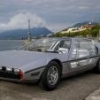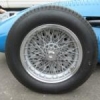Knowing that many members of The Nostalgia Forum have a very broad interest in all aspects of transport and vehicles outside of motorsport, I wanted to bring to your attention an important anniversary that is linked to the true origin of all motor vehicles - le Fardier de Cugnot that was originally constructed in 1769.
I am carrying out some research into a large scale (1/6th as far as I can estimate of le Fardier at the National Motor Museum. This model has been in the care of the National Motor Museum for the past decade, although it is currently in store, and is recorded as being on loan from the Royal Automobile Club. The RAC has very little in terms of trying to establish the model's provenance but their Golden Jubilee book of 1947 refers to it being on display at Pall Mall. Please see an attached photograph and I apologise for its quality. Entirely down to myself, but it is fairly dimly lit in the museum store! The extract from the Golden Jubilee book indicates that the model was exhibited at Pall Mall in 1947 which could suggest that it may also have been an element in the exhibitions organised for the Golden Jubilee of the British motor industry organised the year before. A research trail that potentially rivals those featured in the BBC's "Fake or Fortune"!
The story of Cugnot is one that I discovered when I was a small child and it has fascinated me ever since. The original vehicle is preserved (and has been since about 1800 at the request of Napoleon Bonaparte)) in le Musée des Arts et Métiers in Paris. I have also followed the building of two replica / reconstructions - one in Florida and one in France - in recent years and have seen both in steam. Retromobile in 2011 for the Tampa vehicle and in 2022 for the French one. I visited an event in Panningen in the Netherlands where le Fardier was being demonstrated last year to specifically speak with engineer Fabrice Gennison, the leader of the French replica project which is totally authentic to Cugnot’s original, about the possibility of bringing the vehicle to the UK in a couple of years time. I renewed that conversation with Fabrice at an event in Sampigny, near Commercy, in August this year.
The model showcase bears a makers plate from a Paris modelmaker and is an obviously Victorian era museum display case. An expert on early high pressure steam has looked at the photographs of the model and is of the opinion that it may have been made from the extant engineering drawings that are contemporary to Cugnot’s time as a military engineer. The potential date of the showcase made me wonder if the model had been made for the Exposition Universelle of 1889 in Paris prior to coming to the UK.
On the 26th of February 2025 it will be the 300th anniversary of Nicolas Joseph Cugnot’s birth in 1725 in the small town of Void-Vacon in Eastern France. The French replica of le Fardier is based there and a newly created museum structure is nearing completion with the aim of opening the venue on the Centenary date.
If any of our learned friends can add anything further to this tale, please feel free to post. In particular, if there are any members of the Royal Automobile Club who recall the model being exhibited there, or who may know how it came to the UK, please feel free to post.
The story of the building of then two replicas in recent years - as well as one constructed by the German railways for a documentary film in the 1930s (yes really) and which is kept at the DB Museum in Nuremberg - is quite fascinating. I'll post some further information in due course.
RAC Golden Jubilee Book extract (above) and the almost complete Cugnot Museum in Void-Vacon



















